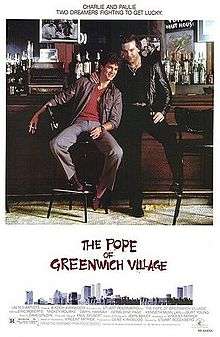The Pope of Greenwich Village
| The Pope of Greenwich Village | |
|---|---|
 Theatrical Poster[1] | |
| Directed by | Stuart Rosenberg |
| Produced by |
|
| Written by | Vincent Patrick |
| Based on |
The Pope of Greenwich Village by Vincent Patrick |
| Starring | |
| Music by | Dave Grusin |
| Cinematography | John Bailey |
Production company | |
| Distributed by | Metro-Goldwyn-Mayer |
Release dates |
|
Running time | 121 minutes |
| Language | English |
| Box office | $6.8 million (US)[2] |
The Pope of Greenwich Village is a 1984 American crime black comedy film directed by Stuart Rosenberg and starring Mickey Rourke, Eric Roberts, Daryl Hannah, Geraldine Page, Kenneth McMillan and Burt Young. Page was nominated for the Academy Award for Best Supporting Actress for her two-scene role. The film was adapted by screenwriter Vincent Patrick from his novel of the same name.
Plot
In an Italian neighborhood of Greenwich Village, cousins Charlie (Rourke), a maître d' with aspirations of someday owning his own restaurant, and Paulie (Roberts), a schemer who works as a waiter, have expensive tastes but not much money. Paulie gets caught skimming checks, and he and Charlie are both fired. Now out of work and in debt, Charlie must find another way to pay his alimony, support his pregnant girlfriend Diane (Hannah), and try to buy a restaurant.
Paulie comes to Charlie with a "can't-miss" robbery, involving a large amount of cash in the safe of a local business. Charlie reluctantly agrees to participate, and they manage to crack the safe with help from an accomplice, Barney (McMillan), a clock repairman and locksmith. But things go sour, resulting in the accidental death of police officer Walter "Bunky" Ritter, who had been secretly taping "Bed Bug" Eddie Grant (Young). Charlie soon learns that the money they stole belongs to Eddie.
The mob figures out that Paulie is involved, and not even his Uncle Pete, part of Eddie's crew, can help him. One of Paulie's thumbs is severed as punishment.
Diane leaves Charlie and takes his money to support their unborn child, while Paulie is forced to work as a waiter for Eddie. He gives the mob Barney's name but initially refuses to identify Charlie as the third man involved. However, under pressure, he is forced to rat on his cousin. Barney leaves town and Charlie mails him his cut of the loot. And when Charlie makes $20,000 on a horse, things begin to look up.
Charlie prepares for a showdown with Eddie, armed with a copy of the tape that the police officer made. But at the last moment, Paulie puts lye in Eddie's coffee. Then he and Charlie casually walk away from Greenwich Village.
Cast
- Eric Roberts as Paulie
- Mickey Rourke as Charlie
- Daryl Hannah as Diane
- Geraldine Page as Mrs. Ritter
- Kenneth McMillan as Barney
- Tony Musante as Pete
- M. Emmet Walsh as Burns
- Burt Young as Bed Bug Eddie
- Jack Kehoe as Bunky
- Philip Bosco as Paulie's Father
- Val Avery as Nunzi
- Joe Grifasi as Jimmy the Cheese Man
- Tony DiBenedetto as Ronnie
- Ronald Maccone as Nicky
- Betty Miller as Nora
- Tony Lip as Frankie
- Frank Vincent as 1st Crew Chief
- Jacques Sandulescu as Chef
- Leonard Termo as Fat Waldo[3]
Production
This film was originally planned as the first on-screen pairing of legendary actors Robert De Niro and Al Pacino, with De Niro playing Charlie and Pacino playing Paulie.[4] Michael Cimino was initially slated to direct Pope. After Rourke and Roberts signed on as the leads, Cimino wanted to finesse the screenplay with some rewriting and restructuring. However, the rewriting would have taken Cimino beyond the mandated start date for shooting, so Cimino and MGM parted ways.[5]
Reception
Roger Ebert of the Chicago Sun-Times gave the film three stars, saying, "It's worth seeing for the acting, and it's got some good laughs in it, and New York is colorfully observed, but don't tell me this movie is about human nature, because it's not; it's about acting."[6]
Leonard Maltin gave the film three stars, describing it as a "Richly textured, sharply observant film... Page stands out in great supporting cast."[7]
References
- ↑ "The Pope of Greenwich Village Poster". IMP Awards. Retrieved 2011-04-21.
- ↑ "The Pope of Greenwich Village". Box Office Mojo. Retrieved 2016-10-13.
- ↑ Barnes, Mike (2012-11-02). "Character Actor Leonard Termo Dies at 77". The Hollywood Reporter. Retrieved 2012-11-22.
- ↑ Heard, p. 40.
- ↑ Heard, p. 42.
- ↑ Ebert, Roger (1984). "The Pope of Greenwich Village". Chicago Sun-Times. Retrieved 2011-04-21.
- ↑ Maltin, Leonard (August 2008). Leonard Maltin's Movie Guide (2009 ed.). New York, NY: Penguin Group. p. 1086. ISBN 978-0-452-28978-9.
Bibliography
- Heard, Christopher (2006). "Chapter Six: Iconic Measures". Mickey Rourke: High and Low. London, England: Plexus Publishing Ltd. ISBN 978-0-85965-386-2.
Notes
- Ebert, Roger (March 6, 1986). "Eric Roberts: Star 86". Chicago Sun-Times. Retrieved 2011-04-21.
External links
- The Pope of Greenwich Village at the Internet Movie Database
- The Pope of Greenwich Village at Rotten Tomatoes